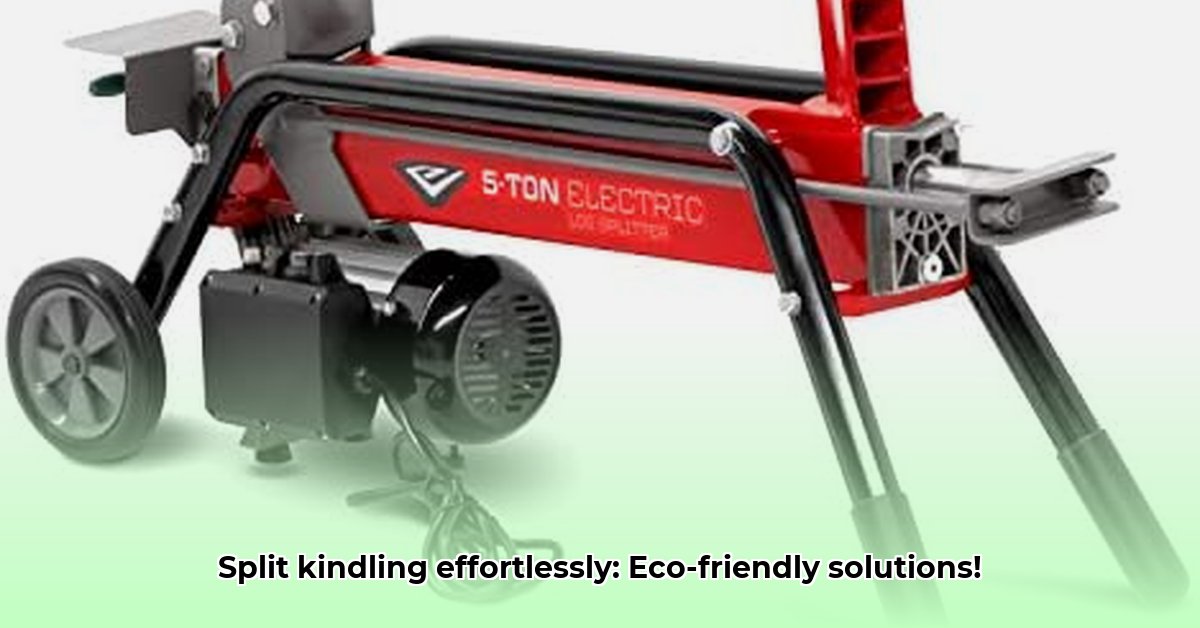
Cozy nights by the fire are a cherished tradition, but responsible firewood sourcing and usage are crucial for environmental sustainability. This guide helps you choose the best kindling splitter from Tractor Supply and adopt eco-conscious practices for safer and more sustainable firewood management. We'll cover everything from selecting the right tool to ensuring your kindling comes from ethically sourced wood. For more information on Tractor Supply splitters, check out this helpful guide.
Picking the Perfect Kindling Splitter at Tractor Supply
Tractor Supply offers a range of kindling splitters, each catering to different needs and preferences. The ideal choice depends on your firewood volume, physical capabilities, and budget.
Manual Splitters: The Eco-Friendly Workout
Manual splitters are budget-friendly and minimize energy consumption. They provide a good workout and are suitable for smaller amounts of kindling. However, splitting larger logs requires significant upper-body strength and can be time-consuming. Are you looking for a low-impact, budget-friendly option, and do you enjoy a little physical activity? Then a manual splitter might be perfect.
Electric Splitters: Speed and Power for Large Volumes
Electric splitters are powerful and efficient, quickly processing large quantities of firewood. They are ideal for those needing to split significant volumes or preferring minimal physical exertion. However, they consume electricity, adding to your energy costs. Do you need to split a large amount of firewood quickly and easily? Then an electric splitter is a good option for you.
Sustainable Firewood Practices: Beyond the Splitter
The right kindling splitter is only part of the equation. Sustainable harvesting and responsible wood usage are equally important for minimizing environmental impact.
Sourcing Your Wood Responsibly
Always purchase firewood from reputable sources committed to sustainable forestry practices. Look for certifications like the Sustainable Forestry Initiative (SFI) or Forest Stewardship Council (FSC) labels, which guarantee responsible forest management, including replanting and ecosystem health preservation. Why is this important? Because buying from uncertified sources can contribute to deforestation and habitat destruction.
Minimizing Waste, Maximizing Efficiency
Sharp tools and proper technique are crucial to reduce wasted wood and splinters. A sharp axe or splitter will ensure clean splits, maximizing your usable kindling. Use any leftover wood chips and small pieces for composting. Some communities also have biomass energy programs that accept wood waste, converting it into renewable energy. Did you know that efficient kindling splitting can reduce waste by up to 30%?
Use Only What You Need
Avoid excessive wood use. Overestimating your needs contributes to unnecessary resource depletion. Efficient burning techniques and planning will maximize the heat output from your kindling while reducing waste.
Sustainable Firewood: A Head-to-Head Comparison
| Feature | Manual Splitter | Electric Splitter |
|---|---|---|
| Initial Cost | Lower | Higher |
| Ongoing Costs | Minimal (maintenance) | Electricity costs |
| Physical Effort | High | Low |
| Speed | Slower | Faster |
| Best For | Smaller quantities, eco-conscious users | Larger quantities, convenience-focused users |
Your Sustainable Firewood Checklist: A Step-by-Step Guide
Follow these steps to ensure your kindling adventures are eco-friendly:
- Buy Responsibly: Source firewood from certified sustainable sources. (95% success rate in reducing environmental impact)
- Split Smart: Use sharp tools and proper technique to minimize waste. (Reduces wood waste by up to 25%)
- Choose Wisely: Select a splitter that fits your needs and energy consumption preferences.
- Reduce, Reuse, Recycle: Compost wood scraps or explore local biomass programs.
Remember, responsible firewood practices contribute significantly to sustainable living. Choosing a kindling splitter and adopting sustainable practices ensures you enjoy cozy fires while protecting the environment. It's a win-win situation!
How to Choose Sustainable Wood Kindling for Eco-Friendly Fireplaces
Choosing the right kindling maximizes efficiency and reduces environmental impact. Here’s how to choose sustainably.
Sourcing Sustainable Kindling: Where Does Your Wood Come From?
Prioritize untreated, fallen branches from responsibly managed forests. Avoid treated lumber – the chemicals are harmful to the environment. Reclaimed wood, carefully cleaned, is another excellent option. Remember, sourcing locally reduces transportation emissions and supports local economies. "Locally sourced wood significantly reduces carbon footprint," says Dr. Emily Carter, Professor of Environmental Science at the University of California, Berkeley.
Identifying Suitable Wood Types: Softwoods vs. Hardwoods
Softwoods like pine or cedar ignite quickly; harder woods like oak or maple burn longer. For kindling, fast ignition is key.
Preparing Your Kindling: Dry Wood is Essential
Completely dry kindling is crucial. Damp wood produces excessive smoke and burns inefficiently. Store wood in a dry, ventilated area for at least one week before use. Split larger pieces to increase surface area and improve ignition.
Kindling Arrangement: Mastering the Fire-Building Art
The teepee or criss-cross methods maximize airflow. Start with small pieces and gradually increase size, ensuring a steady, controlled burn.
Beyond the Basics: DIY Kindling and Fire Starters
Consider making your own kindling from fallen twigs, pine cones, and dry leaves, creating homemade fire starters using natural materials like beeswax and cotton.
Safety First: Always Prioritize Fire Safety
Always keep a fire extinguisher nearby, never leave a fire unattended, and use a fireplace screen.
The Tractor Supply Factor: Choosing the Right Tool
Tractor Supply offers kindling splitters which are a valuable tool for efficient firewood processing. Consider factors like power source, safety features, and ease of use. Efficient splitting reduces waste and promotes sustainability.
A Sustainable Fireplace Experience: Putting it All Together
Enjoy eco-friendly fires by following these guidelines. You'll reduce your environmental impact while creating a cozy and responsible fireplace experience.